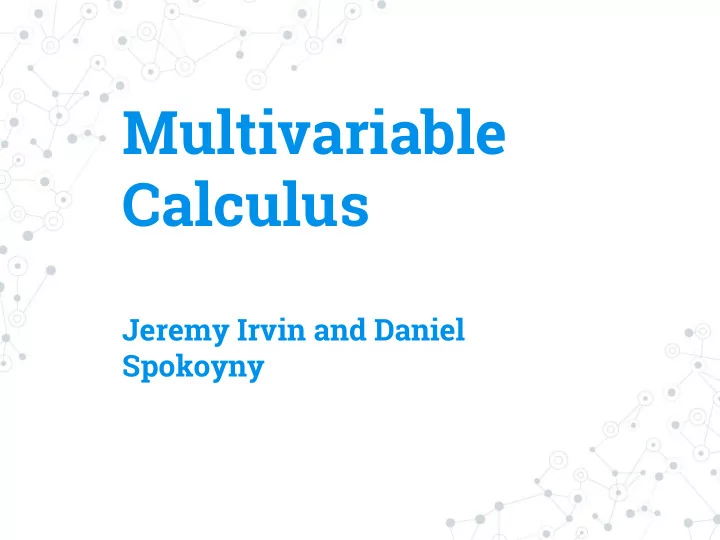

Multivariable Calculus Jeremy Irvin and Daniel Spokoyny
Derivative ● Let be open. A function is differentiable at if exists. We call this value f’(x) . ● Intuitively, a function is differentiable if it is locally approximated by a line.
Derivative ● If f is differentiable, we can rewrite this as ● Or equivalently,
Derivative ● Now let be open, and . Then f is differentiable at if such that ● Intuitively, f is differentiable if it is locally approximated by a linear function.
Partial Derivative ● Let . The jth partial derivative of f at is provided this limit exists.
Total and Partial Derivative ● Now let and . We can write ● And if and , writing the component of x out explicitly,
Total and Partial Derivative ● So we can define ● Because f’(x) is linear, it can be represented as a matrix, call it . In fact,
Total and Partial Derivative ● If f is real-valued ( ), then the matrix representation of f’(x) is called the gradient of f at x , denoted ● Think of the gradient as a direction in which the parameters move so that the function f increases the fastest.
Convexity ● Let . A function is convex if for all , ● This means that the line between any two points on the graph of f lies above the graph of f (see blackboard). ● Convex functions have a single global optimum.
Lagrange Multipliers Jeremy Irvin and Daniel Spokoyny
Lagrange Multipliers ● Suppose is continuously differentiable, and let M be the set of points such that and . If the differentiable function attains its maximum or minimum on M at the point , then is called the “Lagrange multiplier”.
Lagrange Multiplier Example ● Find the rectangular box of volume 1000 which has the least total surface area A . ● Let and . ● We want to minimize f on the set of points which satisfy . ● Sounds like Lagrange Multipliers!
Lagrange Multiplier Example ● ● ● We want to solve ● It is easily seen that the unique solution to this set of equations is x=y=z=10 .
Generalized Lagrange Multipliers ● Informally, given some constraints , and denoting M the set of points which satisfy them, if (under some conditions on these constraints) the differentiable function attains a local maximum or minimum on M at , then ● So to find points which optimize f given some constraints, simply solve the set of equations above.
Matrix Calculus
Matrix Gradient ● Let (input matrix, output real value). The gradient of f with respect to some input is the matrix of partial derivatives: ● More compactly,
Matrix Derivative Properties
Hessian ● Suppose . The Hessian matrix with respect to x is the n x n matrix of partial derivatives: ● More compactly,
Gradients/ Hessians of Quadratic/ Linear Functions
What Just Happened? ● Multivariable Derivative ● Convexity ● Lagrange Multipliers ● Matrix Calculus
Done with math!! (kinda)
Recommend
More recommend